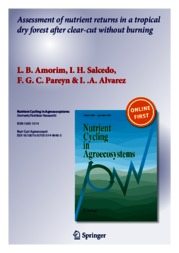Assessment of nutrient returns in a tropical dry forest after clear-cut without burning.
Assessment of nutrient returns in a tropical dry forest after clear-cut without burning.
Author(s): AMORIM, L. B.; SALCEDO, I. H.; PAREYN, F. G. C.; ALVAREZ, I. A.
Summary: Tropical dry forests (TDFs) are being deforested at unprecedented rates. The slash/burn/ agriculture/fallow-extensive livestock sequence causes significant nutrient losses and soil degradation. Our aim is to assess nutrient inputs and outputs in a TDF area under an alternative management system, for exclusive wood production. The study involved clear-cutting a preserved caatinga TDF site without burning, quantifying nutrients exported in firewood/ timber and nutrients returned to the soil from the litter layer plus the slash debris, left to decompose unburned on the soil surface. Before clear-cut, the litter layer on the forest floor contained 6.1 t ha of dry matter (DM). After clear-cut, the aboveground biomass was 61.9 t DM ha-1 (consisting of 21.5 t DM ha-1 of commercial wood and 40.4 t DM ha-1 of clear-cut debris that did not include the underlying litter layer). The litter layer was composed of fine and coarse litter, with turnovers of 0.86 and 0.31 year-1, respectively, separately measured in uncut control plots during two rainy seasons (Dec-2007/June-2008 and Dec-2008/ June-2009). In a single season, its decomposition returned to the soil 48.4, 1.16 and 12.3 kg ha-1 of N, P and K. The clear-cut debris was mainly composed of branches, 33.4 t ha-1, bromeliads, 5.63 t ha-1 and green leaves, 1.32 t ha-1. In-situ decomposition rates for branches and bromeliads were 0.24 and 1.47 year-1, respectively. After two rainy seasons the clear-cut debris released 206, 6.5 and 106 kg ha-1 of N, P and K respectively. This input plus that of the underlying litter layer exceeded exports in the commercial wood, and replenished a soil nutrient stock (0?30 cm) of approximately the same magnitude.
Publication year: 2014
Types of publication: Journal article
Unit: Embrapa Territorial
Keywords: Caatinga, Debris decomposition, Litter decomposition, Nutrient cycling
Observation
Some of Embrapa's publications are published as ePub files. To read them, use or download one of the following free software options to your computer or mobile device. Android: Google Play Books; IOS: iBooks; Windows and Linux: Calibre.
Access other publications
Access the Agricultural Research Database (BDPA) to consult Embrapa's full library collection and records.
Visit Embrapa Bookstore to purchase books and other publications sold by Embrapa.

